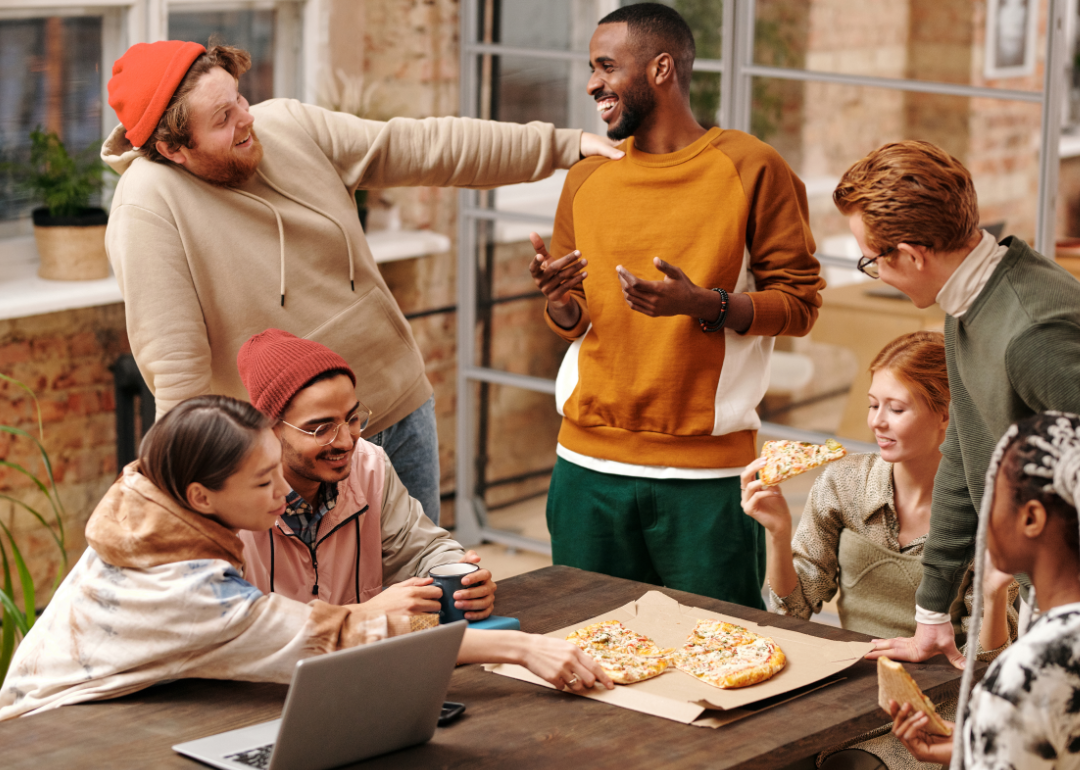7 simple ways to improve social connection

Canva
7 simple ways to improve social connection
A group of coworkers enthusiastically socialize in an office space.
Know what feels good? Interacting with strangers. That’s right, researchers have observed that smiling at a random person can improve your mood and your sense of belonging. It’s a simple thing, a small gesture. So why don’t we all do it more often?
Perhaps because we’re too busy looking at our phones.
A 2019 study published in Computers in Human Behavior evaluated strangers in a waiting room — some with phones, some without — and found that those without their phones were more likely to smile at others. Researchers surmise it’s not that people with phones wouldn’t look up if someone tried to engage them; it’s that their behavior signals disinterest to those around them.
It’s tempting to blame technology for fraying social ties. Nicholas Epley, Ph.D., professor of behavioral science at the University of Chicago Booth School of Business, believes that the bigger problem may be with us. After all, he says, in certain settings, people have always been reluctant to engage with one another.
As an example, he points to the work of social psychologist Stanley Milgram, Ph.D., whose research more than 50 years ago included sending his students to interact with strangers on the subway. Even before mobile phones, people often preferred to keep to themselves.
Similar behavior continues today, often to our detriment. Epley’s recent research observed participants commuting on trains and buses. Some were instructed to interact with others, and some were not. Although participants in both camps expected to prefer solitude, those who made connections reported a more positive experience.
Assuming that others prefer to be left alone prevents us from reaching out. Our misunderstanding, Epley explains, keeps us from socializing enough for our own well-being.
Embracing “Micro-Moments”
Epley believes we miss out on a lot of happiness by not engaging when among fellow humans. Too many of us will feel a sense of appreciation for someone but not share it, or we’ll overhear a kind word about someone but neglect to pass it on.
“It doesn’t take more time or energy,” he says. “In fact, it can give you energy, but people undervalue how positive these experiences can be.”
What’s more, Barbara Fredrickson, Ph.D., notes that when we forgo such opportunities, we deny ourselves the chance to love and be loved.
In her book “Love 2.0: Creating Happiness and Health in Moments of Connection,” Fredrickson challenges us to reconsider what we typically assume about love — that it’s exclusive, unconditional, and reserved for intimate relationships.
On the contrary, Fredrickson suggests, the opportunity for love is present anytime two people — even strangers — connect over a shared feeling. “Those pleasant yet fleeting moments of connection that you experience with others expand your awareness in ways that accrue to create lasting and beneficial changes in your life,” she writes. “Micro-moments like these are those essential nutrients of which most of us in modern life aren’t getting enough.”
These micro-moments offer significant health benefits, including increased emotional resilience and greater immunity.
So, how can we prioritize more human connection in our lives? First, put your phone away. Without that distraction, it will be easier for you to read the situation you’re in and decide how to engage, keeping in mind that everyone’s preferences will vary. Then, try some of these other ideas Experience Life has compiled for making connections.
![]()

Canva
Connection concepts
An older couple engages in conversation and laughter with a younger woman.
1. Speak
Even among strangers, if it feels OK, try saying something. Make an observation that falls within the context of your environment — the rainbow you’ve just spotted, the funny saying on someone’s T-shirt, whatever comes to mind. It might seem silly, but it could be a micro-moment for you and others.
Of course, with people you know, conversation is a vital mode of connection. In her book, “Reclaiming Conversation: The Power of Talk in a Digital Age,” Sherry Turkle, Ph.D., writes that face-to-face conversation is our most human and humanizing act. “Fully present to one another, we learn to listen,” she writes. “It’s where we develop the capacity for empathy. It’s where we experience the joy of being heard, of being understood.”
2. Smile
Whether you’re greeting a stranger on the sidewalk or saying hi to a dear friend, smiling triggers the release of feel-good hormones, unleashing the same pleasure in the brain as chocolate. This is true even if your smile is forced: Moving those muscles in your face stimulates the vagus nerve and activates the parasympathetic nervous system, helping you feel calm and safe. It can also signal to others that you’re open to social connection.
3. Look
A 2019 study revealed that eye contact between two people activates the parts of the brain that allow us to process another person’s feelings so we can empathize with them. It’s a valuable form of nonverbal communication that indicates one’s attentiveness to what the other person is saying.
4. Ask
Posing open-ended questions shows your interest in what the other person has to say and increases the potential for strengthening your social bond. Remembering what they say — and circling back with them later — shows that you care, improving your connection.
5. Be Silent
Not everyone is wired the same way or wants to engage in the same amount of talking or touch, says Mona Kay, MSW, Ph.D., founder of Neurodiverse Love and host of the podcast by the same name. “Some neurodiverse individuals may have sensory sensitivities that make certain sounds, scents, or types of touch painful or difficult to experience. In addition, a common neurotypical thought is that if you’re not talking, you’re not connecting.”
Forms of parallel play — such as being in the same room while focusing on different things, or doing the same activity in silence (like reading or working on a puzzle) — can also build connection.
6. Touch
This is not for everyone, especially during a pandemic and especially with strangers, but when you’re in conversation with someone you know well, touch is the most literal of ways to connect.
It spurs the release of the hormone oxytocin, which increases our sense of trust and bonding with loved ones. Welcome physical touch can also ease stress, lower blood pressure, boost immune function, and improve self-esteem.
7. Listen
Use simple gestures to show you’re engaged and present. A nod of the head indicates you understand. Leaning in or vocalizing an “mm-hmm” says you’re following what’s being said. Zen teacher Ben Connelly believes that our whole-hearted attention is one of the greatest gifts we can offer to someone.
Reaching out to connect with someone, of course, carries a built-in risk; it’s not guaranteed to go well. Although less common than we might expect, awkward interactions do happen. When this occurs, don’t take it personally — and the next time you’re faced with the choice to engage or hold back, err on the side of choosing connection.
This story originally appeared on Experience Life and has been independently reviewed to meet journalistic standards.
